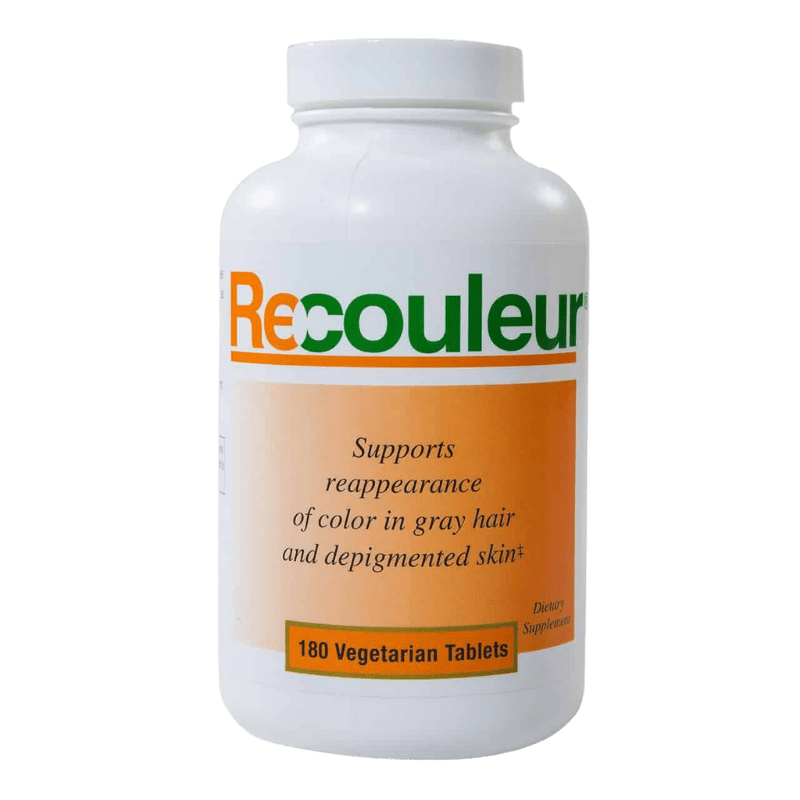
Recouleur® Vitamins
$99.99
Developed by Experts, A Patented Formula Supporting Vitiligo Skin Health
Vitamins and minerals are important in the treatment of vitiligo and for both depigmented skin and gray hair. Certain vitamins are beneficial for vitiligo. Many people with vitiligo are also deficient in specific vitamins. Just read the following studies to better understand the best vitamins and minerals for vitiligo:
“Abnormally low levels of Vitamin B12, Folic Acid and Vitamin C are found in a large number of vitiligo patients.”Vitiligo: Nutritional Therapy, by Leopoldo Montes, M.D., M.S., FRCPC Westhoven Press, Buenos Aires.
“Patients with vitiligo show diminished blood levels of folic acid, Vitamin B12, and ascorbic acid (vitamin C). Prolonged oral administration of these vitamins was followed by definite repigmentation without side affects,” Folic Acid and Vitamin B12 in Vitiligo: A Nutritional Approach, Cutis Magazine, Volume 50, July 1992.
“(Vitiligo) has been corrected by giving pantothenic acid or PABA.” (PABA is a constituent of folic acid.) Let’s Get Well, by Adelle Davis, A Signet Book from New American Library.
“Pantothenic Acid and PABA (an element of folic acid) supplements are effective in managing vitiligo,” Mental and Elemental Nutrients, by Carl C. Pfeiffer, Keats Publishing, Inc., New Canaan, CT.
“A group of 48 people ranging in age from 10-70 years were given all B vitamins. Within two months, the white areas turned pinkish, and after six months, all 48 people were reportedly free of the colorless patches.” Natural Healing, by Mark Bricklin, Rodale Press, Inc., Ammaus, PA.
“In India, BEHL (1994), a vitiligo expert who has probably managed more vitiligo patients than any other dermatologist worldwide, has observed copper deficiency in the serum and in the skin of vitiligo patients.” Vitiligo: Nutritional Therapy, by Leopoldo Montes, M.D., M.S., FRCPC, Westhoven Press, Buenos Aires.
“Folic acid and vitamin B12 supplementation combined with sun exposure can induce repigmentation better than either the vitamins or sun exposure alone.” Improvement of Vitiligo after Oral Treatment with Vitamin B12 and Folic Acid and the Importance of Sun Exposure, by Juhlin L., Olsson MJ., Department of Dermatology, University Hospital, Upssala, Sweden.
“Nutritional deficiencies, both in animals and in humans, are known to alter melanin production. Copper and zinc deficiencies have been reported to induce hypopigmentation in various animals. Hypopigmentation of the skin and hair results from copper deficiency in humans; the depigmentation associated with chronic excessive molybdenum intake is related to a decreased storage of copper in the liver. Copper would seem of prime importance because tyrosinase is a known copper-requiring enzyme.” Vitiligo and Other Hypomelanoses of Hair and Skin, by Jean-Paul Ortonne, M.D., Plenum Medical Book Company, NY.
“The content of copper and zinc ions, accepting immediate participation, during melanogenesis, is dropped in depigmenting centers of skin. We have applied adsorbents sated with copper and zinc. The encouraging results expressing in gradual reduction of a pigmentation of injured sites of a skin area obtained. Thus, the complex treatment vitiligo with applicates copper and zinc containing adsorbents normalization of skin pigmenting function.” Application of Copper and Zinc Containing Adsorbents in Complex Vitiligo Treatment, by V.G. Kolyandenko, V.N. Korol, O.N. Bakalinskaya, N.T. Kartel, National Medical University, Kiev, Ukraine.
“Achromotrichia has been claimed as an early indicator of copper insufficiency. This color change is associated with the decreased activity of tyrosinase, a copper-containing polyphenyl oxidase which is required for the synthesis of melanin pigment from tyrosine.” Copper in Animals and Man, Volume II, by John Howell, McC., D.V.Sc., F.R.C.Path. Jeffrey M. Gawthorne, Ph.D., CRC Press, Inc., Boca Raton, FL.
“Among major symptoms of dietary copper deficiency are neutropenia, hypochromic anemia, osteoporosis, decreased pigmentation of the skin, and neurologic disturbances.” Copper Proteins and Copper Enzymes, by Rene Lontie, D.Sc., CRC Press, Inc., Boca Raton, FL.
“Copper-containing polyphenoloxidases such as tyrosinase are involved in the production of melanin from tyrosine. This process is extremely responsive to changes in copper status; loss of pigment from wool, hair, and feathers is a sensitive index to changes in copper deficiency.” Copper in Animals and Man, Volume II, by John Howell, McC., D.V.Sc., F.R.C.Path., Jeffrey M. Gawthorne, Ph.D., CRC Press, Inc., Boca Raton, FL.
“Copper, folic acid, and pantothenic acid have been successful in recoloring gray hair.” Know Your Nutrition, by Linda Clark, Keats Publishing, Inc., New Canaan, CT.
“When pantothenic acid (a B vitamin), used by Dr. Morgan, is absent from an otherwise adequate diet for animals (which is one of the ways we learn what humans also need) the animals’ hair turns gray, anemia and eczema appear, the animals appear old before their time, even when they are young.” Secrets of Health and Beauty, by Linda Clark, The Devin-Adair Co., Old Greenwich, CT.
“The natural color of gray hair has sometimes been restored by an adequate intake of all the anti-gray hair vitamins.”Let’s Get Well, by Adelle Davis.